So, what exactly is airspace?
The FAA identifies two categories of airspace: regulatory and non-regulatory. Within these, all airspace is either controlled, uncontrolled, special use, or other. Pilots must be aware of the various types of airspace to ensure safe flight. For example, to enter some airspace, government agencies require you to have a security clearance. However, it’s not that simple!
Pilots should check NOTAMs for changes regarding access to airspaces. For example, when the President of the United States is flying, airspace becomes restricted. Pilots must recognize the various types of airspace. Here, Captain Judy Rice shares her experiences from her world flight with various types of airspace and issues that can arise.
Topics at a Glance:
- 1. Security Clearances – Getting Permission
- 2. Uncontrolled Airspace – The Airspaces ABCs
- 3. Controlled Airspace
- 4. Special Use Airspace (SUA) / Other
- 5. How to Learn Airspace Classes

Part 1: Security Clearances: You Have to Get Permission
In this article on airspace, I thought it would be useful to share the basics of airspace in the context of my 2015 world flight with Buzz Aldrin. During my world flight, it would have been much easier to simply fly where we wanted to go without asking for permission. That is never the case, however. Every country handles it differently.
For example, on one leg, we filed the Citation jet’s route departing from Yerevan, Armenia (UDYZ) to Tel Aviv, Israel (LLBG). During our pre-briefing, ATC shared we would receive more information once airborne. In other words, we expected an assigned, mandatory security stop before we could be allowed into Israel airspace. What followed surprised us.
How are aircraft cleared for security before landing in countries outside of the U.S.?
Many countries, such as Israel, assign all aircraft a security landing airport before entry into their airspace. We were to land and provide proof of information for our aircraft, crew, and passengers. After that, they would provide a special security code. This code was specific to our aircraft. Therefore, Israel ATC required me to include this when radioing at the time of our requesting entry. If we did not include this special security code, then we would be denied entry into Israeli airspace.
Once airborne, ATC chose Larnaca, Cyprus (LCLK) as our required security landing airport. After that, we could enter Israeli airspace. Our assigned route change was complicated, and it required transition through Turkish airspace. Turkey and Cyprus were politically opposed, and therefore not on friendly terms. During this unrest, air traffic controllers could not share information about any arriving, departing, or transition flights through their airspace. Pilots must be aware of such conflicts and the challenges they present.
What are reporting points for pilots in airspace classes?
All aircraft entering or exiting a nation’s airspace must report before entering or exiting, including the U.S. These reporting points are called Federal Information Regions (FIR) or Air Defense Identification Zones (ADIZ). Aircraft flying into, out of, or through these airspaces must comply. This is due to security and airspace requirements in each country.
Are security clearances different from country to country?
Yes! Each countries maintains its own system for clearing flights to enter. Because of the conflict at the time, we had to be extra vigilant before entering either Turkey or Cyprus airspace. Not reporting our positions could cause severe consequences. Therefore, we prepared for radio silence nearing Turkey and Cyprus FIR boundaries.
It was an awkward moment as we switched frequencies without ATC approval. We switched from Turkey’s control and announced our presence to Cyprus control. The controller welcomed us into Cyprus airspace where we landed without incident.
How tight is security in other countries upon entering their airspace?
Security is serious in most countries, including the presence of armed guards. In Cyprus, armed security guards greeted us. They instructed us to remain in the Citation jet. The guards requested aircraft, crew, and passenger documents. Next, we were escorted to a small building where we entered a locked room with one computer. The guard instructed us to enter all our information onto this computer. He then stated that once our information was verified, the computer would generate 3 “very important” security questions.
The guard further explained. Before we received permission to enter Israeli airspace, we must answer these same questions EXACTLY as entered on this computer. Additionally, we would have to enter our special security code.
How does ATC determine security questions when entering airspace?
Most countries’ ATC ask basic security questions. In fact, the questions they posed to us were more user-friendly than expected. After entering all our documentation, we held our breath and prepared for the 3 questions. My first officer prepared to copy our answers and the special code. We hovered around the computer trying to guess what these “very important” questions could be.
We were amazed by the first question. “What is your favorite color?” The second and third questions had to be the serious questions, and this must be the trick question. However, the second question was, “What is your favorite food?” Certainly, the third question was going to be the hard one. And yet, the third was, “Name an important person in your life.” My first officer wrote down each answer that we had agreed upon on his kneeboard.
What is the transition like flying from one country’s airspace to another?
Surprisingly, entering countries with high security can be fairly smooth, although there can be several heading changes and reporting points along the way. The guard escorted us back to the Citation jet, and after a pre-flight, ATC cleared us for departure. We were ready with our “very important” security answers and security code as we switched from Cyprus to Israeli controllers. Israeli controllers finally asked our security questions after a long wait, with almost twenty minutes of heading changes and reporting points.
My first officer answered when finally asked our three “very important” security questions and security code. Once Israeli controllers deemed we were not a security threat, their communications became friendly, always ending with “shalom,” meaning “peace.”
How do pilots navigate airspace when countries are politically opposed?
Politically opposed nations present challenges to pilots. Aircraft are limited or denied routing through such countries. Pilots often face airspace embargoes, no-fly zones, or unpredicted changes to a FIR or ADIZ. Due to higher costs associate with circumventing blockades, commercial airlines may close. The military may dominate a nation’s airspace classifications and air traffic control system.
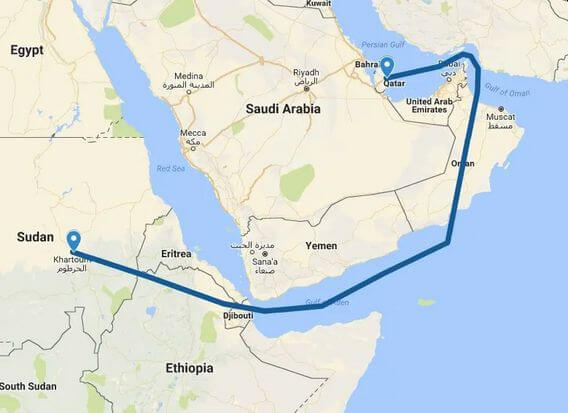
How has airspace been standardized between countries?
In 1941, the United Nations formed the International Civil Aviation Organization (ICAO) to create standards. This included recommended practices concerning air navigation. As worldwide air travel increased, so did the need for safety. Standardized airspace for pilots and air traffic controls increase safety.
Do countries change how the ICAO airspace standards are used?
Yes. The the ICAO divided the world’s navigable airspace into three-dimensional segments. However, some countries chose a two-dimensional approach. They assigned each of these dimensional segments a specific class. Each class has its own rules and regulations. A country’s national aviation authority determines how to use ICAO classifications. For instance, some countries modify the rules to fit security, safety, or services that existed before the ICAO standardization.
Do all countries follow ICAO airspace standards?
Most nations use a version of the ICAO classifications. These include: Class A, Class B, Class C, Class D, Class F, Class E, and Class G. Class F, special use airspace (SUA), is the most widely modified airspace. Many nations, including the U.S., choose their own special use airspace rules and requirements. This includes uncontrolled airspace.
So, are you wondering about the answers to those “very important” security questions? We each answered one question. First, I chose red as favorite color. Next, our first officer chose pita, his favorite food. Lastly, the relief pilot chose his wife, Valentina, as the important person.
Although experiencing numerous changes from the ICAO airspace standardization, the guidelines helped me safely navigate the globe.
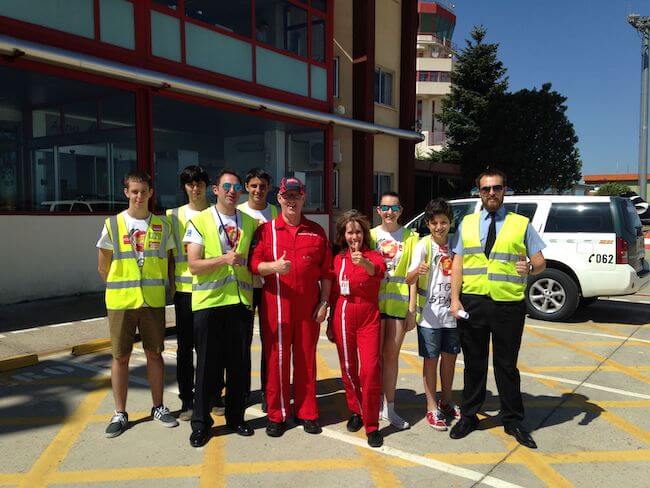
Part 2: Uncontrolled Airspace – The Airspace ABCs
How does ATC help with transitioning airspace?
ATC helps pilots transition safely and efficiently in and out of all types of airspace. ATC approved our Instrument Flight Plan (IFR) as filed for the Citation jet. We were departing Le Bourget, France (LFPB). Our destination was Madrid-Cuatro Vientos airport (LECU). Once we crossed the Federal Information Region (FIR) boundary, ATC cleared us from FL320 (32000’ MSL) to 7000’ MSL. Next, they smoothly handed us over from the French airspace control to Spanish control.
Our descent took us over the Pyrenees mountains and two major rivers, the Ebro and Tagus. We saw Madrid from a distance, perched on a plateau of sand and clay. The breathtaking panorama revealed rivers weaving between the valleys and forests next to the brown mesa of Madrid.
Madrid was an extra special stop. Fly & Fun Flight School had participated on my world flight internet broadcasts for more than 5 years. We had all prepared for this day. For the first time, I was meeting these students in person along with the flight school owner, Julio de Zavala. What excitement when the Citation jet landed with the help of ATC!
Understanding Uncontrolled Airspace Around the World
Uncontrolled airspace is not subject to ATC because it is far less busy than controlled airspace. During the world flight, we shared internet broadcasts with students who connected from around the world. We shared aspects about aviation in our respective countries. Airspace was always a lofty topic. Spanish students discussed the classes of the International Civil Aviation Organization (ICAO) airspace. They explained that Classes A to E are controlled airspace, and Class F and G are uncontrolled.
What are the 4 types of airspace in the U.S.?
In 1993, the United States implemented a slightly modified version of the ICAO classifications. The U.S. airspace includes 4 categories: controlled, uncontrolled, special use airspace, and other.
Controlled Airspace vs. Uncontrolled Airspace
In the United States, controlled airspace surrounds airports with a high volume of air traffic or above 18,000’ MSL. Uncontrolled airspace has no air traffic control (ATC) services.
What is Special Use Airspace and Other Airspace?
Special use airspace (SUA) is designated according to security or safety having different levels of restrictions, whereas Other refers to remaining airspace. The ICAO classifications further define these categories.
Can pilots fly VFR in uncontrolled airspace?
Yes, because uncontrolled airspace is designated as Class G with areas having low volume of air traffic. Most air traffic in Class G fly under Visual Flight Rules (VFR) rules. There are moderate required VFR weather minimums. Also there are no communication or air traffic control requirements. It is the pilot’s responsibility to see and avoid other traffic.
Uncontrolled Airspace – Class G
Class G (Golf), prior to 1993, known as Uncontrolled Airspace
There are 3 dimensions:
- From surface to below 14,500’ MSL
- Surface to below 700’ AGL
- Surface to below 1,200’ AGL
< 10,000 MSL:
- Transponder mode C with altitude reporting, Automatic Dependent Surveillance-Broadcast (ADSB) In or Out
- Aircraft Speed: Mach 1
- VFR weather minimums (1-1-1-1): 1 SM visibilities with cloud clearances 1,000’ above, 1,000’ below, 1SM horizontal of the clouds
> 10,000 MSL:
- No special equipment
- Aircraft Speed: maximum of 250 Kts
- VFR weather minimums:
- DAY (1-1-5-2): 1 SM visibilities with cloud clearances 1,000’ above, 500’ below, and 2,000’ horizontal of clouds
- NIGHT (3-1-5-2): 3 SM visibilities with cloud clearances 1,000’ above, 500’ below, and 2,000’ horizontal of the clouds
> 1200’ AGL, VFR weather minimums:
- DAY 1 SM visibilities, remain clear of the clouds
- NIGHT (3-1-5-2): 3 SM visibilities with cloud clearances 1,000’ above, 500’ below, and 2,000’ horizontal of the clouds
- NIGHT remaining within 1/2 mile of the airport: 1 SM, remain clear of the clouds
> 14,500 MSL, VFR weather minimums (1-1-1-1):
- 1SM visibilities, cloud clearances 1,000’ above, 500’ below, 2,000’ horizontal of the clouds
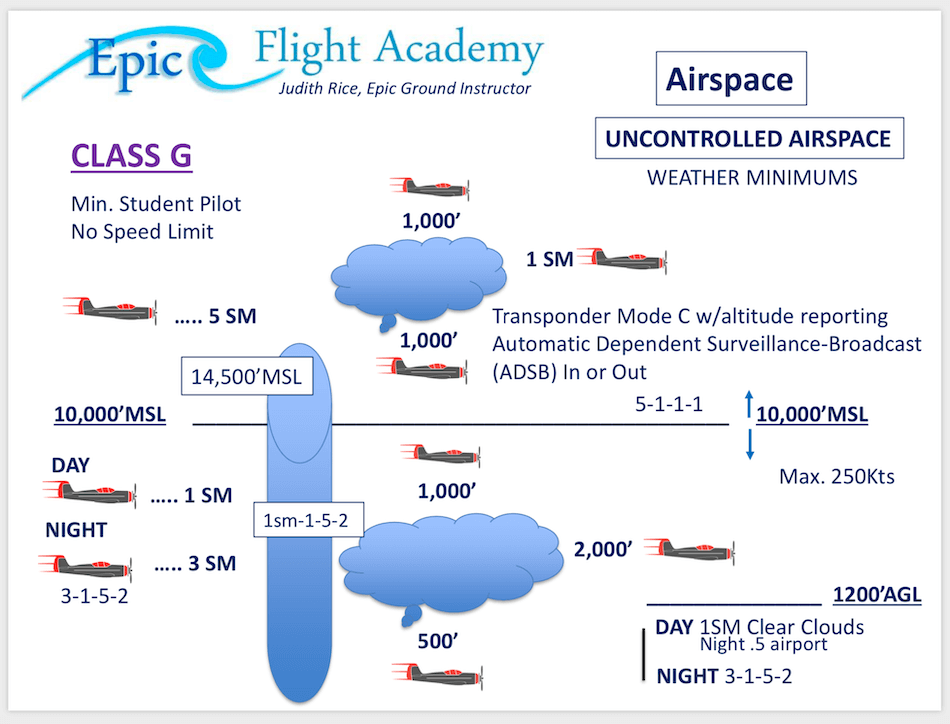
Part 3: Controlled Airspace
What is controlled airspace?
Controlled airspace is typically very busy, covers several dimensions, and ATC provides services. Knowledge of airspace classes is essential for all pilots. ICAO standardized these classes with rules and regulations. They include Class A, B, C, D, E, G, and special use airspace. Most importantly, these designations define clearance requirements, minimums, and dimensions.
Are there speed limits in airspace?
Yes, in the U.S., aircraft may not exceed Mach 1. At >10,000 ft. msl, speed is unrestricted (up to Mach 1). Pilots need to adjust altitude and speed depending on the class of airspace they’re flying in. Also, ATC may require radio contact or communications. Because airspace categories differ, you must learn how to recognize them on charts. Furthermore, you must understand the detailed requirements of each. Besides, authorities established airspace classes to keep you safe. Above all, safety first!
Types of Airspace
First of all, the FAA has identified four types of airspace in the U.S. They are controlled, uncontrolled, special use, and other. Second, each category includes specific airspace use. For example, controlled airspace includes Class A, Class B, Class C, Class D, and Class E. Furthermore, uncontrolled airspace includes Class G. Lastly, special use and other airspace include areas of concern, such as restricted or prohibited airspace.
Not All Airspace is the Same
Certainly, my world flight would have been unlikely without clearly designated airspace. Because of the efforts of the International Civil Aviation Organization (ICAO), flying internationally has become much safer. ICAO’s three-dimensional approach includes helpful rules and regulations. However, some nations chose a two-dimensional approach.
For instance, China chose a two-dimensional approach. In China, each regional authority of the Civil Aviation Administration of China (CAAC) must approve civilian flights. Also, they must get approval by the military before issuing a flight permit. The three-dimensional approach is relevant to air traffic management. For instance, the United States, Europe, and many other nations use this.
National Aviation Authorities Overseeing Airspace
A country’s aviation authority or similar authority determines how it uses the ICAO dimensional approach and classifications. For instance, some countries modified airspace classifications. This was because they addressed security, safety, or air traffic services that existed before ICAO standardization. However, most nations chose a version of the ICAO classification, whether using a three-dimensional or two-dimensional approach. ICAO airspace classes are: Class A, Class B, Class C, Class D, Class E, Class F, and Class G.

Basic Dimensions and Requirements of Airspace Classes
A: What is Class A Airspace?
Class A airspace has the following rules and requirements:
- Controlled
- Extends from 18,000 feet (5,500 m) MSL to FL600.
- Applies to contiguous United States and Alaska.
- Flight levels depend on local atmospheric pressure variations.
- ATC controls all flight operations.
- Pilots must operate as IFR under a clearance received prior to entry.
B: What is Class B Airspace?
Class B airspace has the following rules and requirements:
- Controlled
- “B” is for “busy,” because Class B airspace is found around the busiest airports; for instance, New York and Atlanta.
- Pilots must obtain ATC clearance prior to entry.
- Aircraft must be equipped with a two-way radio
- Also, aircraft must have an operating Mode C transponder, and automatic altitude reporting equipment.
- Exact shape of the airspace varies from one class B area to another.
- Usually shaped like an inverted wedding cake.
- Has series of circular ‘shelves’ of airspace of several thousand feet in thickness, and each is larger than that beneath.
- Centered on a specific airport.
- Normally begins at the surface in the immediate area of the airport.
- Successive shelves of increased radius begin at higher altitudes at greater distances from the airport.
- Some flexibility to accommodate traffic patterns, local topology, etc.
- Upper limit of class B airspace is normally 10,000 feet MSL.
- Speed limit >10,000 ft. msl: 250 kias (200 kias below airspace layers or in VFR corridor.
- Speed limit at 10,000 ft. msl and above: <Mach 1
C: What is Class C Airspace?
Class C airspace has the following rules and requirements:
- Controlled
- Similar to Class B, but on a smaller scale; for instance, Daytona Beach.
- Pilots must establish two-way radio communication with ATC prior to entry.
- Aircraft must be equipped with a two-way radio and operating Mode C radar transponder.
- Aircraft speed must be below 200 knots when at or below 2,500 feet above the ground, and within 4 nautical miles of the airport.
- Typically at airports of moderate size/importance with regular commercial passenger jet service of 100 passengers per flight or more.
- Operational control tower, radar-controlled approach system, and a minimum number of IFR approaches annually.
- Airspace class designation is in effect only during the hours of tower and approach operation.
- Airspace reverts to Class D if approach control is not operating, and to class E or G if the tower is closed.
- Vertical boundary is usually 4,000 feet above the airport surface.
- Core surface area radius is five nautical miles, and it extends from the surface to the ceiling.
- The upper ‘shelf’ area radius is 10 nautical miles extending from as low as 1,200 feet up to the ceiling.
- Speed limit: >200 kias at or below 2,500 ft. agl within 4 nm of airport. ATC may alter this.
D: What is Class D Airspace?
Class D airspace has the following rules and requirements:
- Controlled
- Found at any airport with a functioning control tower, but with few IFR approaches.
- Typically shaped like a cylinder extending from the surface to 2,500 feet above the ground.
- Excludes airspace within the given radius, except in surrounding Class C or Class B airspace.
- Reverts to Class E or G during hours when the tower is closed.
- Establish two-way communication with ATC before entering.
- No transponder is required.
- VFR cloud clearance and visibility requirements are the same as Class C.
- Speed limit: >200 kias at or below 2,500 ft. agl within 4 nm of airport. ATC may alter this.
E: What is Class E Airspace?
Class E airspace has the following rules and requirements:
- Controlled
- No ATC clearance or radio communication required for VFR flight.
- Most airspace in the United States is class E.
- VFR visibility and cloud clearance requirements are the same as for class C and D airspaces when below 10,000 feet MSL.
- Above 10,000 feet MSL, visibility requirement extended to 5 miles.
- Cloud clearance requirement extended to 1,000 feet below clouds, and 1,000 feet above, and 1 lateral mile.
- Includes airspace above FL600.
- Speed limit: 200 kias recommended.
F: What is Class F Airspace?
Class F airspace has the following rules and requirements:
- Not used in the U.S., due to special use areas.
- In Canada, Class F is equivalent to special use airspace in the U.S.
- IACO considers it a hybrid of Class E and Class G.
G: What is Class G Airspace?
Class G airspace has the following rules and requirements:
- Uncontrolled airspace, therefore no radio communication required.
- All airspace below 14,500 feet MSL that is not otherwise classified as controlled.
- No entry or clearance requirements, not even for IFR operations.
- Typically this is the airspace very near the ground (1,200 feet or less). Furthermore, it is beneath Class E airspace, and between class B-D cylinders around towered airstrips.
- VFR visibility requirements: 1 mile by day, 3 miles by night for altitudes below 10,000 feet but above 1,200 feet AGL.
- 5 miles visibility required beginning at 10,000 feet MSL, day and night.
- Cloud clearance requirements: maintain altitude 500 feet below, 1,000 feet above, 2,000 feet horizontal. At or above 10,000 feet MSL, 1,000 feet below, 1,000 feet above, and 1 mile laterally. By day, at 1,200 feet AGL, and below, remain clear of clouds, and no minimum lateral distance.
- Speed limit: 200 kias recommended.
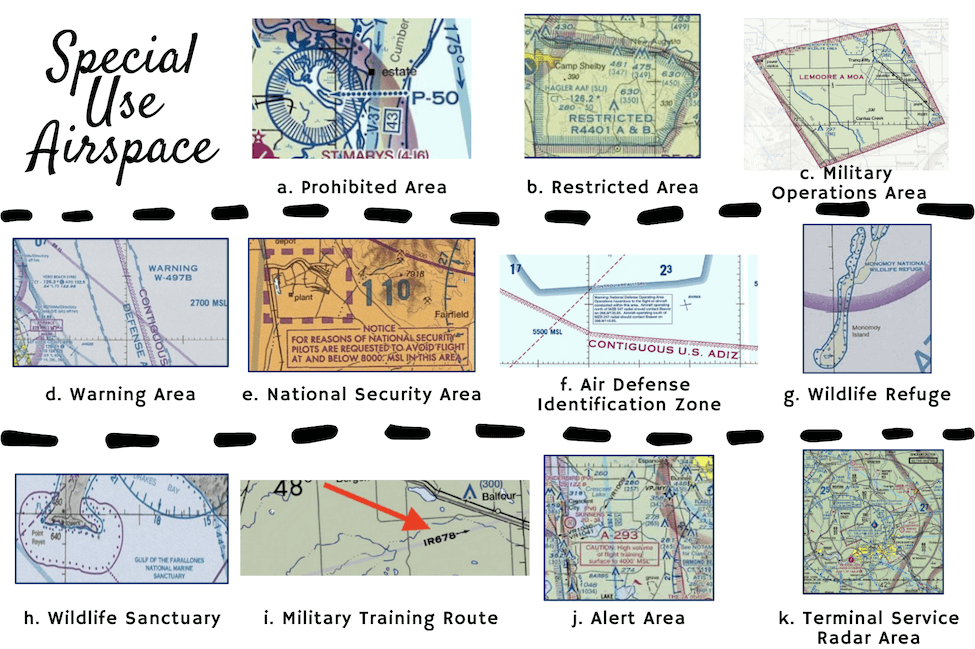
Part 4: Special Use Airspace (SUA) / Other
What is Special Use Airspace?
ICAO designated Class F as either uncontrolled or special use airspace (SUA). The most widely modified class is Class F airspace. Like most countries, the United States established separate SUAs to meet security and safety requirements. Furthermore, SUAs in the U.S. remain mostly unchanged after initial implementation of the ICAO classifications.
What is Other Airspace?
The FAA also classifies some airspace as Other. Other refers to the majority of remaining airspace. This includes:
- Air Defense Identification Zones (ADIZ)
- Flight Restricted Zones (FRZ) at White House and Capitol
- Local Airport Advisory (LAA)
- Military Training Route (MTR)
- National Security Area (NSA)
- NOAA Marine Areas
- Parachute Jump Aircraft Operations
- Published VFR Routes
- Temporary Flight Restriction (TFR)
- Tethered Weather Balloons
- Terminal Radar Service Area (TRSA)
- Wildlife Areas
Requesting Clearance in Special Use Airspace
Due to safety concerns, the FAA established SUAs in the U.S. As a result, military operations, national security, and heavy flight training activities became safer. Therefore, non-participating aircraft are restricted from flying in these areas.
These areas range from prohibited to caution, and this overview of U.S. SUA classifications begins with the most restrictive. Pilots have limited access, and as a result must request the appropriate clearance to enter certain areas. Most importantly, a flight chart (map) displays dimensions of the areas and minimum requirements.
Categories of Special Use Areas:
A. Prohibited Area
Prohibited Areas are established for national security and welfare. A pilot must request clearance from the controlling agency before entering a Prohibited Area. For example, P-50 protects the U.S. Naval Submarine Base at Kings Bay, Georgia.
B. Restricted Area
Restricted Areas contain hazardous activity, such as testing of artillery, missiles, or aerial gunnery. Furthermore, the controlling agency requires clearance. For example, Restricted Area R- 4401 ensures military aircraft conducting high altitude training remain within the confines of that airspace.
C. Military Operations Area
Military Operations Areas (MOA) involve military training activities. Therefore, authorities warn non-participating aircraft to use extreme caution while flying within these areas. Pilots do not need to request clearance, but it is advisable to contact the controlling agency for current hazardous activity. For instance, Lemore MOA contains activities such as, air combat tactics, air intercepts, aerobatics, formation training, and low altitude tactics.
D. Warning Area
Warning Areas are located over domestic or international waters and generally 3 nautical miles surrounding the coasts. Hazardous activities can impact non-participating aircraft. However, no clearance is required to enter. For example, W497B protects airspace during spacecraft operations from Cape Canaveral.
Temporary Flight Restrictions (TFR) temporarily restrict flight activity from operating within a defined area. This protects persons or property in the air or on the ground. The FAA issues TFRs based on the movement of the President or other essential government officials. TFRs can also include disaster relief operations, wildfire response, or large events, and they are issued by NOTAMs.
E. National Security Area
National Security Areas protect the safety and security of personnel on the ground. Authorities request flight activities avoid these areas. For example, a National Security Area would be a nuclear power plant.
F. Air Defense Identification Zone (ADIZ)
Air Defense Identification Zones (ADIZ) include monitored airspace. For example, authorities monitor the identification, location, and control of civil aircraft. This is in the interest of national security. Pilots must file under Instrument Flight Rules (IFR) or Defense Visual Flight Rules (DVFR) before entering or departing the U.S. This can be over land or water.
Airport Advisory Areas occur at non-towered airports with a Flight Service facility. Flight Service provides advisories upon request within 10 NM on the Common Traffic Advisory Frequency (CTAF).
G. Wildlife Refuge
A Wildlife Refuge is specific to land management for wildlife, such as migratory birds. Authorities request that pilots remain 2000’ above ground level (AGL). For example, the Merritt Island National Wildlife Refuge near Cape Canaveral, is a special use area.
H. Wildlife Sanctuary
A Wildlife Sanctuary is an area established to preserve a species. Authorities require flight activities to remain 1000’ AGL. In other words, do not disturb the wildlife!
I. Military Training Route
Military Training Routes contain military training activities along a specific route. Although no clearance is required, pilots may contact the controlling agency for current hazardous activity. As shown, the image with IR indicates military training by instrument reference. VR indicates visual training. Three numbers indicates training activities are above 1500’AGL, and four numbers indicates training at or below 1500’ AGL.
J. Alert Areas
Alert Areas contain a high volume of flight activity. However, authorities do not require clearance to enter these areas. So, pilots must remain extra vigilant looking for traffic when in these areas.
Controlled Firing Areas (CFA) are not found on the Sectional Chart, but they are listed in the Chart Supplement Guide. Activities are conducted in a controlled environment that could be hazardous to nonparticipating aircraft. Again, authorities do not require clearance. However, a pilot may contact the controlling agency for the most current hazardous activity.
K. Terminal Radar Service Area (TRSA)
Terminal Radar Service Area (TRSA) provides advisories for visual flight rule (VFR) pilots in Class D airspace. This includes a high volume of instrument approaches. Participation is voluntary, and pilots may contact the approach control frequency.

Part 5: How to Learn Airspace Classes
From Charts to Flashcards: Effective Methods for Learning Airspace
Every pilot has to learn airspace classes, and everyone has their own method from studying charts to memorizing flashcards. Learning about and navigating SUAs as a student pilot was vital to my safety. Certainly, I consistently relied on this knowledge. It served me well during my world flight. Most importantly, understanding and experiencing airspace in the U.S. provided a solid foundation. This prepared me for my world flight thanks to the standardization efforts by IACO.
Breaking it Down
Airspace may be one of the most complex and important topics that a pilot needs to understand. Learning airspace can seem overwhelming at first with a lot to remember. How did I tackle learning about airspace? I realized that for each airspace classification there are only 3 topics to remember: dimensions, equipment, and Visual Flight Rules (VFR) weather minimums. I then discovered some of these airspace dimensions have the same VFR weather minimums and equipment requirements.
Make Flash Cards
Student pilots were not always so fortunate to have the Internet or cell phones for studying. Students now use online flash cards to study airspace and other topics. I studied airspace before computers and cell phones. Making my own index cards, I placed the classification on the front. I then put the dimensions, weather minimums, and requirements on the back.
I took these flash cards with me everywhere! Waiting in the grocery store line or having car maintenance? No problem – I had my flash cards. I purchased a cassette tape on airspace (today it’d be a mobile phone), and listened in the car or while doing housework. I focused every spare moment on learning airspace.
Studying Sectional Charts
Airspace familiarization on the VFR Sectional Chart is equally important. I studied the sectional chart from the top to the bottom naming the classification and information for each airspace. Your airspace knowledge will come from determination, repetition, study, and focus.
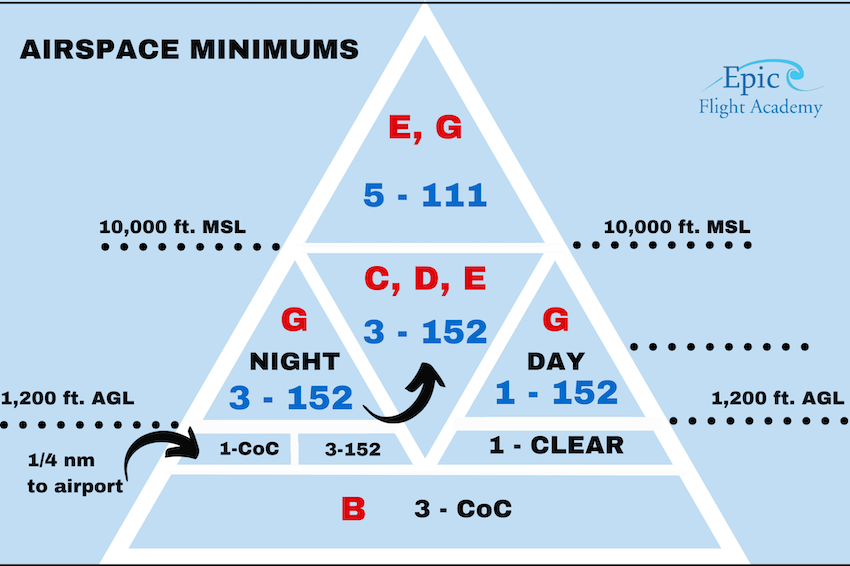
Airspace VFR Weather Minimums Triangle
A lot of flight students teach themselves airspace VFR weather minimums using a triangle. It provides a quick visual reminder of rules and exceptions to the rules, such as day and night minimums.
In the United States, some student pilots find airspace to be a difficult topic. However, it just takes a little effort to learn. During my world travels, students from other nations are often amazed at the freedom for flight in the U.S. Understanding airspace is small price to pay. After all, we enjoy greater opportunities to “slip the surly bonds of Earth and dance the skies on laughter-silvered wing!”

Did you know…?
Drones, or unmanned aircraft systems (UAM), must adhere to airspace rules, too. For instance, the FAA prohibits flying drones over rescue or emergency operations, such as hurricanes and wildfires. Small drones can only fly up to 400 feet AGL. If you are a drone operator, learn the rules. The FAA legally defines drones as aircraft. Therefore, you are accountable for knowing when and where you can safely fly your drone.

Read more articles by Captain Judy Rice!


As always, awesome explanation in detail of Airspace Captain Judy!!
It is a Privilege been an Epic’s Student having you as our Instructor on each lesson on the classroom!!
Thank you, Christopher! We agree – Captain Judy’s articles are detailed and informative!